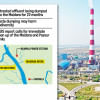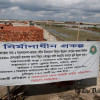Save the Sundarbans vs. How to Save the Sundarbans
Should we save the Sundarbans? How can we save the Sundarbans? Can we risk the existence of the Sundarbans for a power plant?
I can see the government answering the first question again and again. It is like a broken record that stops after answering the first question and then repeats it and then starts from the beginning again every time you try to listen to the answer to the next questions. The government has assured us from time to time that it has been doing everything to protect the Sundarbans. Under the current government, the Bangladesh Constitution was amended in 2011 to include a constitutional directive to the State to protect the environment and natural resources for current and future generations. Prime Minister Sheikh Hasina, who won the Champions of the Earth award, has said "all of our activities have been targeted toward adaptation to environmental changes with a view to protecting human lives from floods and hurricanes, and protecting the environment from pollution caused by rapid urbanisation and unsustainable industrialisation." In the Global Tiger Stocktaking Conference in 2014, the Prime Minister stressed the need to save the Sundarbans for its rich biodiversity, besides the precious Royal Bengal Tiger. She also pointed out that the Sundarbans is a natural protector of the southern coastal areas of Bangladesh from cyclones and other calamities originating at the Bay of Bengal.
The PM is so very accurate when it comes to stressing the need to protect the Sundarbans. But, when the second and third question has to be answered, I can hear all the contradictory arguments floating in the air. Let us look at the chronology of events and dissenting views of the government of Bangladesh. The Bangladesh Power Development Board (BPDB) and National Thermal Power Corporation (NTPC) signed a joint venture agreement on January 29, 2012 to build a 1320 MW plant of the Bangladesh India Friendship Power Company Ltd (BIFPCL), with equal ownership of Bangladesh's BPDB and India's NTPC. The 1,834 acre land acquisition order was given on December 27, 2010, almost two and half years before the Environmental Impact Assessment Report was approved on August 5, 2013. While the environmental assessment plan was approved for a 1320 MW power plant, the government still has a plan to increase the capacity of the first power plant to 2640 MW. Besides, we came to know about the plan to build Orion's 565 MW power plant in 2014, after 200 acre land acquisition was complete.

In a letter dated September 29, 2011, the chief conservationist of the Department of Forest expressed the opinion that if a coal-based power plant is constructed near the Sundarbans area of Khulna, it would harm the biodiversity of the Sundarbans. The ministry was thus requested to reconsider the construction of a coal-based power plant on account of the importance of preserving the biodiversity of the Sundarbans Ramsar Site. In 2013, while unveiling the foundation plaque for the Rampal power plant amid growing public concern, Prime Minister Sheikh Hasina asserted that the power plant would not cause any harm to the Sundarbans or the livelihood of the people in the surrounding areas. On February 15, 2016, the Finance Minister, after a meeting with the World Bank, said "There would be some impact obviously; so many boats will come, carrying so much coal, the flora and fauna will be substantially affected by this." Right after talking about the harmful impacts, he referred to the EIA and said the harmful effects of the project are not that severe, and assured that there is no possibility of cancelling the project.
The cacophony of the dissenting opinions within the government indicates that we live in a world where no one can certainly predict the risk of the project. It is not the inability of the government to do scientific research to assess the risks; it is the inability to make sure that all these risks can be mitigated by an environmental management plan. And from here, we can start finding the answer to the second question: how to save the Sundarbans? One simple answer to this question is by leaving the Sundarbans alone, without any human intervention. The only thing the government can do to save the Sundarbans is to minimise human intervention by not polluting the nearby area, by not disturbing the animals and birds, by not allowing boats to carry goods, by not polluting the rivers with harmful substances, and by not polluting the air that can harm the plants. If building the Rampal power plant proves to be one of the most damaging human interventions to the Sundarbans then no matter how the government asserts its intention to save the Sundarbans, can anybody really rely on such well-publicised good intention?
To answer the third question, "Should we put the Sundarbans at risk?", the first thing an economist would do is to look for an alternative site. The government has not given us any alternative before deciding on using the site at Rampal, which is 14kms away from the Sundarbans. Instead, the people in favour of this project ask the protestors to "give us some alternatives for electricity production". Although the protesters, including the National Committee to Protect Oil Gas Mineral Resources Power and Port, offered many alternatives, the government has not yet provided any alternative site to select from. Although the environmental management plan of this project proposed to minimise the water pollution and to build ash ponds, the risk cannot be completely eliminated. We have seen how ash spread over in North Carolina's Dan River from the ash pond created by Duke Energy. Besides, the authority's inability to clean oil during the 2014 oil spill is still fresh in people's memory. We still remember the negligence in environmental management, and are sceptical about the state's desire to protect the forest. Even if we become most optimistic and expect that there will be no negligence, it is still not worth taking the risk when we know that the damage to this unique ecological site is irreperable. This project will not destroy the forest in a day. As the flora and fauna are dependent on each other, the destruction may start with the exinction of a small insect and may result in poor reproductive health of animals in the future.
From March 10-13, thousands of people will participate in the people's march to save the Sundarbans. Amidst the many slogans that the people's march will use, one slogan states, "There are many alternatives to electricity production, there is no alternative to the Sundarbans."
The expressions of doubt and confusion in many supporters of the government on the question of the Sunderbans will be easily visible on their faces, but they won't say a thing. Why? Of course, no one is denying the need for energy for development. But people do not necessarily want a development that risks the existence of the Sundarbans. I understand that this group of people may not join the people's march to save the Sundarbans, but their hearts are with those on the streets to save the largest mangrove forest of the world. The media may not televise and print about the passion stirred through the people's march but that does not mean that people are not with the movement. Their silence has nothing to do with the lack of trust on the movement; rather their silence says a lot about the current government's unilateral decision and tolerance to resistance. Let us avoid asserting the need to save the Sundarbans and focus more on how to save it and why it's important to stop any project that risks its existence.
The writer is Assistant Professor of Economics, Department of Accounting and Information Systems, University of Dhaka.

 For all latest news, follow The Daily Star's Google News channel.
For all latest news, follow The Daily Star's Google News channel. 








Comments